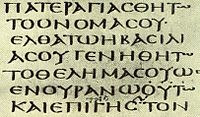|
Luke 11
Luke 11 is the eleventh chapter of the Gospel of Luke in the New Testament of the Christian Bible. It records Luke's version of the Lord's Prayer and several parables and teachings told by Jesus Christ.[1] The book containing this chapter is anonymous, but early Christian tradition uniformly affirmed that Luke the Evangelist composed this Gospel as well as the Acts of the Apostles.[2] TextThe original text was written in Koine Greek. Some early manuscripts containing the text of this chapter are:
This chapter is divided into 54 verses. The Lord's Prayer The chapter opens with Jesus praying in "a certain place" and being asked by one of his disciples to teach them to pray, as John the Baptist had taught his disciples.[3] The place is not named but the context is within Jesus' "journey to Jerusalem" which he has commenced, with his disciples, in Luke 9:51. Frederic Farrar suggests that Luke "did not possess a ... definite note of place or of time".[4] The form of prayer taught by John the Baptist has perished.[4] In reply, Jesus taught his disciples the "model prayer",[5] known generally as the Lord's Prayer. Some writers looking at Matthew's account (Matthew 6:9–13) alongside Luke's account have argued that the disciple was probably a later recruit to Jesus' entourage and therefore not present at the Sermon on the Mount.[6] Eric Franklin notes the "appropriate" connection between this section and the end of chapter 10, where Mary's listening to Jesus has been commended rather than Martha's activism.[7]: 942 A friend comes at midnight
 For Luke, the Lord's Prayer has a strongly eschatological focus: it prays for the coming of the Kingdom of God and maintaining that until such coming, Jesus' disciples "should live under its shadow and out of its strength". So Luke follows on from the prayer with a parable which speaks of the need for urgent and insistent prayer, portrayed through "a determined petition for bread". The parable indicates that God is not indifferent during this time of waiting, and Franklin observes that any suggestion to the contrary "arises out of a misreading of the signs of the times".[7]: 943 Farrar adds an allegorical reading in his assessment of this story:
Keep asking, seeking, knocking
The text here:
mirrors Luke's text at 6:38:
God's responsiveness to persistent prayer can be understood in the light of the parable of the friend at midnight and the persistence in seeking help which it represents. Verses 11-12 maintain the theme of asking:
Luke gives three examples of possible requests, two matching Matthew's account, asking for a loaf, and for a fish,[12] and a third of his own, requesting an egg. Codex Bezae omits the first example.[13] Meyer sees in this passage an example of the literary technique known as anacoluthon, an unexpected discontinuity in the expression of ideas.[6] He who does not gather with me scatters Luke 11:23b, also Matthew 12:30. Baptist theologian John Gill suggests that "the allusion [in verse 23b] is either to the gathering of the sheep into the fold, and the scattering of them by the wolf; or to the gathering of the wheat, and binding it in sheaves, and bringing it home in harvest; and to the scattering of the wheat loose in the field, whereby it is lost".[14] Woes of the PhariseesVerses 37-54 enumerate a number of criticisms raised by Jesus against scribes (lawyers) and Pharisees, which are also recorded in Matthew 23:1–39.[15] Mark 12:35–40 and Luke 20:45–47 also include warnings about scribes. See also
References
External links
|
|||||||||||||||||
Portal di Ensiklopedia Dunia
